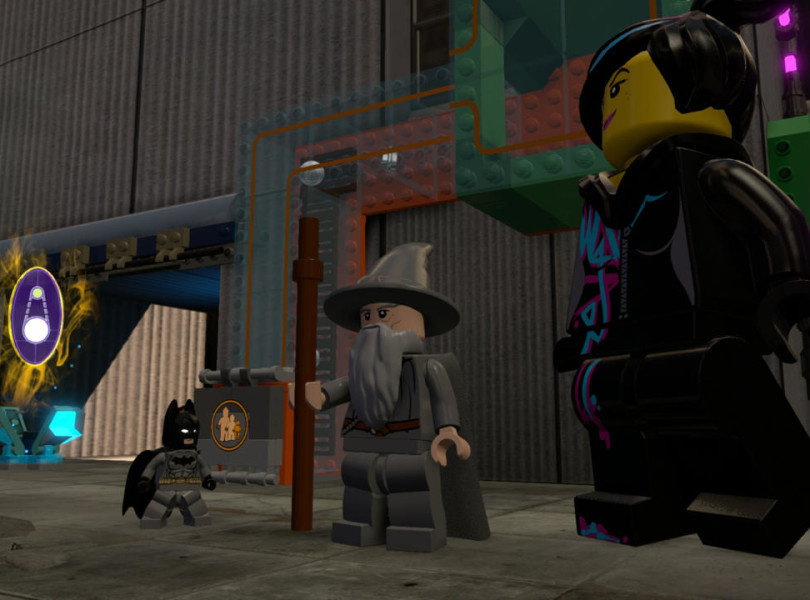LEGO Dimensions starts in an unusual way: it asks you not to play the game. After some short, perfunctory in-game tasks, Dimensions takes a swerve, telling you to put your controller down and build (using actual LEGO pieces) a physical portal that sits atop the real-world base you’ll use to interact with the game. The portal itself is attractive and intricate, and depending on your fine motor skills (and whether you have children helping/hindering you), could take at least an hour to build.
You don’t actually have to physically build anything to progress within the game, but that off-game opening speaks to a confidence developer TT Games seemingly has in LEGO Dimensions, both as an actual toy and a virtual one. It’s a confidence that’s well founded. The appeal of building LEGO is near universal, and only the biggest curmudgeons would deny the appeal of Dimension’s charming fusion of several huge entertainment franchises within its sprawling gameplay. LEGO Dimensions works unquestionably, unequivocally, as both a toy and a game, and it feels like the high point of the many LEGO titles that have come before it.
What’s remarkable is that despite Dimensions being the long-running LEGO series’ first foray into the toys-to-life genre, the newly physical nature of this game isn’t its most noteworthy aspect. Previous LEGO games have showcased the series’ irreverent, playful takes on huge pop culture franchises, but Dimensions significantly ups the ante by shoving multiple properties into one gigantic mash-up. The in-game premise is that the evil Lord Vortech is attempting to destroy all of the various LEGO dimensions and combine them into one; in reality, it’s a handy excuse to see worlds and characters from some major franchises collide, including The Lord of the Rings, the DC universe, Doctor Who, The Simpsons, the Portal games, The LEGO Movie, and more kid-friendly series like Scooby Doo, Ninjago, and Legends of Chima.
The result is, in many cases, outstanding. There’s an undeniable joy to be had in seeing Batman use the Bat Signal to defeat Sauron, or the Joker destroy the Springfield Nuclear Power Plant, or the off-handed way the Doctor addresses Portal’s GLaDOS as the “faulty A.I.”. My favourite–and forgive me for venturing into possible spoilers here (skip to the next paragraph if you’re wary)–is a short sequence during the boss fight with GLaDOS. In the midst of this fight, a dimensional rift appears, pulling in HAL 9000 from 2001: A Space Odyssey in the room. HAL is supposed to be a distraction, an opportunity for you to defeat GLaDOS during her preoccupation with the strange AI that just popped into her testing chamber. Instead, I put my controller down and just listened, transfixed by the pair’s hilarious banter.

Many of the dimensions the game takes you to is filled with moments like these, and I looked forward to every rift, every intrusion, wondering what was going to happen next. The LEGO games’ light touch and cheeky nose-tweaking of the franchises it portrays has always been one of the series’ highlights, and it’s in fine form here. Doctor Who‘s world, for example, is impressive. Nods to fans abound, from Bad Wolf graffiti on walls, to mysterious, glowing cracks in surfaces, to the excellent way the menace of the Weeping Angels was translated into a child-friendly video game. The stages based on classic Midway games, too, show ingenuity, changing the game to a top-down Gauntlet-like experience in one instance, to a 2D-shooter in another.
Other worlds were less impressive. The Wild West of Back to the Future is nondescript, feeling little like the source material outside of a few folks named after characters in the third BTTF movie. The New York of the Ghostbusters world, too, felt lacking. But even in the midst of my disappointment, I heard some of the cheesy ’80s pop songs from the Ghostbusters soundtrack play, and I smiled. In LEGO Dimensions, the little touches are oft times as affecting as the major strokes.

Despite the age of some of these franchises, make no mistake: while much of the humor, references, and gags may be aimed at grown-up gamers, LEGO Dimensions is still unabashedly a family-friendly game, one that’s best played with an adult assisting a child. The game’s basic foundations remains true to previous LEGO titles–simple combat and controls, and no real penalty for dying. Each of the characters you control features one or two abilities specific to them–these become the basis for solving the game’s most simple puzzles. Only Batman, for example, can use a Batarang to activate a switch, while Gandalf’s magic is required to move certain blocks. This simplicity sometimes led to frustrations in Dimensions–driving controls, for example, felt too rudimentary, making it fiddly to manoeuvre vehicles into tight spots.
But the gameplay strength of the LEGO series has always been with its environmental puzzles, and Dimensions features some of the most creative yet seen in the series. They start simply, with the game giving you the ability to teleport characters around, or change their size, or lend them specific elemental powers. By the end, when you’re asked to combine powers in increasingly intricate ways to progress past puzzles, finding the right solutions was often times rewarding.

LEGO Dimensions comes with physical LEGO pieces that you have to build into sets (like the aforementioned portal base), characters, vehicles, or accessories. You place the characters, vehicles, or accessories (which you attach to small discs, which is where all of the information on that particular piece is stored) on the base, and voila: they’ll pop up on your television ready to be controlled. The game’s starter pack comes with Batman, Gandalf, and Wyldstyle (from The LEGO Movie), as well as the Batmobile.
You can complete the main narrative with the starter pack alone, but as is the case with other toys-to-life games, some content is locked to specific characters or sets that require separate purchase. In this case, characters and objects from the other worlds within Dimensions are sold separately which, if you’re a veteran of the LEGO games, can seem somewhat annoying. Needing specific characters to access areas or activities is nothing new in a LEGO game–you simply had to amass enough in-game studs to purchase. In Dimensions, you’ll have to use real money. Thankfully, there’s a significant amount of content available within just the basic pack; finishing the main quest line should take more than 12 hours, depending on how obsessive you are about collecting studs within levels.
Outside of the narrative, Dimensions also features large, open world sections dedicated to each franchise, and all you need is a character from that franchise to unlock it (that means with the starter pack, you have The Lord of the Rings, DC Universe, and LEGO Movie open worlds already unlocked). These open world sections are separate from the main narrative and include various activities like checkpoint races, simple quests, and plenty of collectibles. While they don’t feature the same level of intricacy the main game provides, they do add several more hours each to the overall experience, so the pain of buying a Homer Simpson pack just so you can use him within the main game can be somewhat mitigated knowing it also unlocks a virtual Springfield for you to play in.

So far, so basic for a game in the toys-to-life genre. But LEGO Dimensions takes things a step further. It requires you to almost constantly interact with the real LEGO figures on your base to solve in-game puzzles or avoid in-game obstacles, with the base having three different sections that light up depending on what’s happening on screen. Wicked Witch of the West got Batman trapped in magical chains? Simply move the Batman figure off the red-colored area of the base to free him. Need to teleport a character to a specific spot within the level? Then move the real toy onto the appropriate color-matched spot on the base. Some of Dimensions’ most complex puzzles and challenging bosses require a huge amount of moving toys around, making the game an extremely tactile experience. In LEGO Dimensions, sometimes you’re manipulating real LEGO as much as you are holding a controller.
Make no mistake: while much of the humor, references, and gags may be aimed at grown-up gamers, LEGO Dimensions is still unabashedly a family-friendly game, one that’s best played with an adult assisting a child.
It’s this real world activity that makes Dimensions a unique experience. As toys, these are in every way the same as any other LEGO set you would buy–great build quality, simple in design but often times intricate in construction, and fully adaptable with other LEGO bricks you already have. There’s nothing stopping you from putting Gandalf’s hat on Batman, or ignoring instructions and building the portal to your own design, or even foregoing building altogether (after all, all you need to actually play the game are the ID discs for each character). But for me, Dimensions’ endearing nature and interactivity with the real world made me want to build, and it’s a feeling that’s bound to intensify if you play with a young one.
In the first few hours of LEGO Dimensions play time with my six-year-old son, almost half the time was spent on playing with blocks. We built the portal together. We built the Batmobile, and then opened up a Scooby Doo pack and built the power-up Scooby Snack and Mystery Machine located within. We then hit the Wizard of Oz world, with Batman’s head comically poking out the top of the Mystery Machine. In any game within the toys-to-life genre, there’s sometimes an unspoken question: is this also a great toy or just a great game? In LEGO Dimensions’ case, the answer is easy: it’s both.


